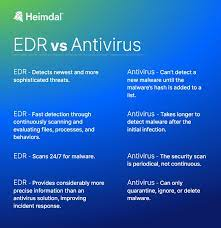Next Generation Antivirus VS EDR If your business relies on traditional antivirus protection (AV), now may be the time to upgrade. Hackers and cybercriminals constantly adapt their tactics, techniques, and procedures (TTPs) to bypass current AV solutions.
Next-generation antivirus (NGAV) utilizes advanced analytics and machine learning techniques to correlate multiple alerts across a network quickly. NGAV can be deployed quickly as a cloud-based security solution without additional hardware or software requirements.

Detection
Traditional antivirus solutions use signature lists to detect malware; next-generation antivirus (NGAV) employs more advanced detection techniques that identify previously unknown threats, such as machine learning, behavioral analysis, and more, to anticipate and stop attackers before they even gain entry to your network.
Next-gen antivirus (NGAV) solutions distinguish themselves from legacy antivirus software and EDR solutions by their method of detecting attacks. While both can protect your company against attacks, only NGAV aims to enhance its defenses further by stopping attacks before they reach endpoints in the first place.
NGAV utilizes cloud-based technology to monitor your entire network of endpoints and devices in real-time and identify any suspicious activity automatically – without compromising performance, disrupting users or business operations, or needing extra hardware/software/tuning on your part – quickly deployable within hours and seamlessly integrated into existing security environments.
Legacy antivirus software has long been seen as ineffective against newer threats such as file-less malware and zero-day attacks. However, this shouldn’t be taken as evidence that their vendors lack the capabilities required to deal with their rapid evolution by attackers.
Response
Cyberattacks against your business involve more than viruses, ransomware, and other malware – cybercriminals constantly devise ways to bypass security protections and breach them with sophisticated threats like file-less techniques. Therefore, Antivirus protection should be a top priority to protect your organization against these sophisticated threats.
While traditional antivirus software scans files to detect threats, next-generation antivirus solutions (NGAVs) take a more comprehensive approach by looking at behavior. They analyze processes, data, application usage patterns, network traffic analysis, and end-user activity patterns for suspicious signs that could indicate an attack is underway.
This approach makes it more difficult for attackers to enter your business systems and snoop around your network in search of sensitive data, safeguarding employees’ productivity and customers’ safety while protecting your information from intrusion. This enables you to keep employees productive, and customers secure, all the while securing data protection.
NGAV solutions tend to be cloud-based, which makes implementation faster and reduces their impact on endpoint devices. Traditional antivirus can use up a significant portion of each device’s bandwidth as it must often update its threat database.
While more detection technology won’t stop all attacks, it can help your organization stay one step ahead. A combination of more innovative detection focused on prevention and enhanced response capabilities capable of responding in real-time to attacks is the ideal way to protect against modern threats and keep your business safe.
Visibility
Legacy antivirus (AV) solutions often produce numerous alerts that are difficult to interpret. One could indicate a RAT (Remote Access Trojan) loader is active on a machine; another might show files attempting to download ransomware; yet still another could report applications being exploited to gain entry – all these attacks must be tracked, evaluated, and resolved quickly or else further damage could ensue for your organization.
Next-generation antivirus can offer relief. By employing threat hunting, behavioral detection, machine learning algorithms, and exploit mitigation capabilities, NGAV can stop advanced threats that cannot be identified using traditional signature-based methods.
NGAV stands out from traditional antivirus solutions by being cloud-based and needing no integration with an organization’s existing security protocols, making deployment quick with minimal performance impact on devices. Plus, frequent updates ensure it keeps pace with cybercriminal tools and tactics used against you.
Performance
Since cyber-attacks and malware continue to evolve, traditional antivirus programs no longer provide enough protection. That is where next-generation antivirus (NGAV) programs come into play.
NGAV differs from traditional antivirus software because it uses artificial intelligence and machine learning to identify threats and prevent them from impacting your endpoints. Furthermore, this system detects attacks not based on files by scanning events, processes, and connections and exploits mitigation layers for attacks that might otherwise slip past its defenses.
Heuristic analysis allows NGAV to detect threats by looking at the structure and behavior of programs rather than solely their code. Web protection helps block access to bad neighborhoods like ad networks and scammer pits while hardening reduces vulnerability, exploits surface area, and fingerprinting recognizes entire malware families.
NGAV stands apart from traditional antivirus solutions by being able to immediately act upon threats identified, quarantining them, stopping malicious activity by blocking infected systems and applications, and rolling back an affected device to its previous state if required – capabilities which truly set it apart from traditional solutions.
EDR solutions deployed to customers in Milwaukee use advanced prevention measures rooted in artificial intelligence and machine learning, including heuristics, machine learning, custom allowlisting/blocklisting capabilities, attack attribution methods, and more to put attackers off balance. These preventive tools scan networks without relying on large threat libraries that require updating periodically.
